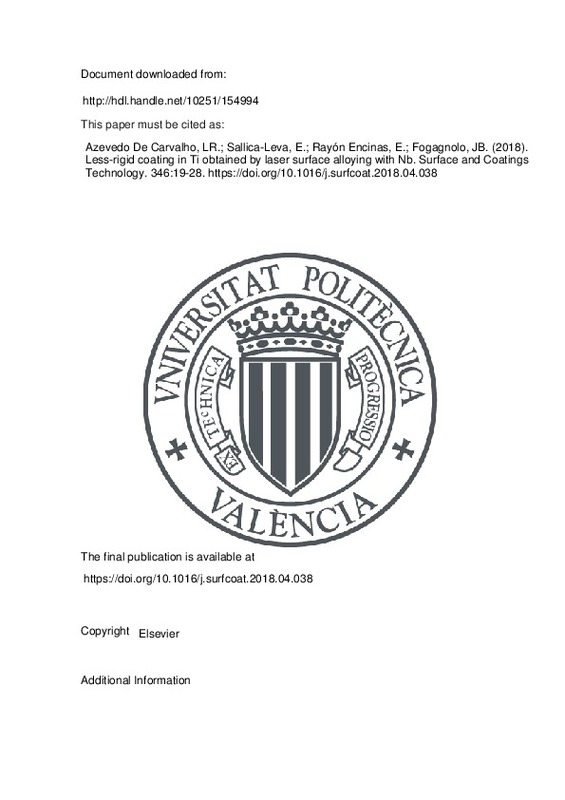JavaScript is disabled for your browser. Some features of this site may not work without it.
Buscar en RiuNet
Listar
Mi cuenta
Estadísticas
Ayuda RiuNet
Admin. UPV
Less-rigid coating in Ti obtained by laser surface alloying with Nb
Mostrar el registro sencillo del ítem
Ficheros en el ítem
| dc.contributor.author | Azevedo de Carvalho, Lisiane Rocha
|
es_ES |
| dc.contributor.author | Sallica-Leva, Edwin
|
es_ES |
| dc.contributor.author | Rayón Encinas, Emilio
|
es_ES |
| dc.contributor.author | Fogagnolo, Joao Batista
|
es_ES |
| dc.date.accessioned | 2020-11-13T04:31:46Z | |
| dc.date.available | 2020-11-13T04:31:46Z | |
| dc.date.issued | 2018-07-25 | es_ES |
| dc.identifier.issn | 0257-8972 | es_ES |
| dc.identifier.uri | http://hdl.handle.net/10251/154994 | |
| dc.description.abstract | [EN] The fabrication of parts with stiffness gradation specifically designed to attain higher mechanical and/or biomedical performance is receiving increasing scientific and technological interest. This work reports the use of laser surface alloying to introduce Nb into the surface layer of Ti pieces and thus obtain continuous coatings composed of Ti-Nb alloys. By controlling the laser processing parameters, coatings with lower Young's modulus and higher hardness compared to the substrate, practically free of cracks and with very low porosity were obtained, using energy densities in the range of 24 to 65 J/mm(2). However, compositional heterogeneity mainly due to microsegregation during the solidification process was observed. Increasing the energy density resulted in deeper fusion zones, which increased the substrate fusion and thus decreased the Nb content and produced a coating with a microstructure predominantly composed of alpha/alpha' acicular phase. On the other hand, the Nb content of the coatings produced with lower energy densities was high enough (similar to 20-30%(in) (mass)) to (meta) stabilize the less-rigid alpha" and beta phases, which promoted the highest reductions in the Young's modulus of the investigated coatings. Besides the lower stiffness, all coatings presented at least twice the hardness of the substrate. Maps of the properties constructed from the nanoindentation results showed that, despite the compositional heterogeneity, homogenous values of Young's modulus and hardness were attained and the change in the interface region was gradual, in agreement with the concept of functionally graded materials. | es_ES |
| dc.description.sponsorship | The authors gratefully acknowledge the Sao Paulo State Research Foundation (FAPESP, Brazil) (Grant 2011/19982-2) for its financial support. | es_ES |
| dc.language | Inglés | es_ES |
| dc.publisher | Elsevier | es_ES |
| dc.relation.ispartof | Surface and Coatings Technology | es_ES |
| dc.rights | Reserva de todos los derechos | es_ES |
| dc.subject | Functionally graded materials | es_ES |
| dc.subject | Surface stiffness gradient | es_ES |
| dc.subject | Ti-Nb alloys | es_ES |
| dc.subject | Surface engineering | es_ES |
| dc.subject | Instrumented indentation | es_ES |
| dc.subject.classification | CIENCIA DE LOS MATERIALES E INGENIERIA METALURGICA | es_ES |
| dc.title | Less-rigid coating in Ti obtained by laser surface alloying with Nb | es_ES |
| dc.type | Artículo | es_ES |
| dc.identifier.doi | 10.1016/j.surfcoat.2018.04.038 | es_ES |
| dc.relation.projectID | info:eu-repo/grantAgreement/FAPESP//2011%2F19982-2/ | es_ES |
| dc.rights.accessRights | Abierto | es_ES |
| dc.contributor.affiliation | Universitat Politècnica de València. Instituto de Tecnología de Materiales - Institut de Tecnologia de Materials | es_ES |
| dc.description.bibliographicCitation | Azevedo De Carvalho, LR.; Sallica-Leva, E.; Rayón Encinas, E.; Fogagnolo, JB. (2018). Less-rigid coating in Ti obtained by laser surface alloying with Nb. Surface and Coatings Technology. 346:19-28. https://doi.org/10.1016/j.surfcoat.2018.04.038 | es_ES |
| dc.description.accrualMethod | S | es_ES |
| dc.relation.publisherversion | https://doi.org/10.1016/j.surfcoat.2018.04.038 | es_ES |
| dc.description.upvformatpinicio | 19 | es_ES |
| dc.description.upvformatpfin | 28 | es_ES |
| dc.type.version | info:eu-repo/semantics/publishedVersion | es_ES |
| dc.description.volume | 346 | es_ES |
| dc.relation.pasarela | S\361956 | es_ES |
| dc.contributor.funder | Fundação de Amparo à Pesquisa do Estado de São Paulo | es_ES |







![[Cerrado]](/themes/UPV/images/candado.png)

